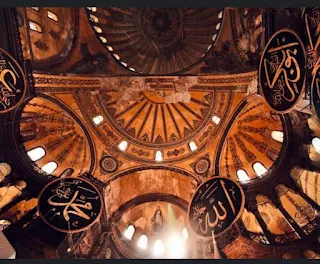*அல்குர்ஆன் வாசிப்பு தொடர் 1*
أَعُوْذُ بِاللهِ مِنَ الشَّـيْطٰنِ الرَّجِيْمِ
بِسْمِ ٱللَّهِ ٱلرَّحْمَـٰنِ ٱلرَّحِيمِ⭘
அளவிலா அருளாளன், நிகரிலா அன்பாளன் அல்லாஹ்வின் பெயரால்..
ٱلْحَمْدُ لِلَّهِ رَبِّ ٱلْعَـٰلَمِينَ⭘
அகிலங்களின் இறைவனாகிய அல்லாஹ்வுக்கே எல்லாப் புகழும்
ٱلرَّحْمَـٰنِ ٱلرَّحِيمِ⭘
(அவன்) அளவிலா அருளாளன்; நிகரிலா அன்பாளன்
مَـٰلِكِ يَوْمِ ٱلدِّينِ⭘
தீர்ப்பு நாளின் அரசன்
إِيَّاكَ نَعْبُدُ وَإِيَّاكَ نَسْتَعِينُ⭘
உன்னையே நாங்கள் வணங்குகிறோம். உன்னிடமே உதவி தேடுகிறோம்.
صِرَٰطَ ٱلَّذِينَ أَنْعَمْتَ عَلَيْهِمْ غَيْرِ ٱلْمَغْضُوبِ عَلَيْهِمْ وَلَا ٱلضَّآلِّينَ⭘
(அது) நீ யாருக்கு அருள் புரிந்தாயோ அவர்களின் வழி! அவர்கள் (உன்னால்) கோபிக்கப்பட்டவர்கள் அல்ல; வழி தவறியவர்களும் அல்ல!
அல் குர்ஆன் - 1 : 1 - 7
=======================
📌 சூரத்துல் ஃபாத்திஹா சிறப்புகள்.
“பிஸ்மில்லாஹிர் ரஹ்மானிர் ரஹீம்” என்ற முதல் வசனம்தான் ஓர் அத்தியாயத்தை மற்றோர் அத்தியாயத்திலிருந்து பிரித்துக் காட்டுவதற்குரியதாகும்.
நபி (ஸல்) அவர்கள் “பிஸ்மில்லாஹிர் ரஹ்மானிர் ரஹீம்” என்ற வசனம் இறங்கும்வரை ஓர் அத்தியாயம் முடிந்து விட்டது என்பதை அறிய மாட்டார்கள்.
அறிவிப்பவர்: இப்னு அப்பாஸ் (ரலி), நூல்கள்: மஃரிபத்துஸ் ஸுனனுல் ஆஸார்(3061), ஹாகிம் (845),தப்ரானீ - அவ்ஸத் (2869), பஸ்ஸார் (4979)
ஃபாத்திஹா அத்தியாயத்தைத் ‘திருக்குர்ஆனின் அன்னை’ என்றும், ‘தோற்றுவாய்’ என்றும், ‘திரும்பத் திரும்ப ஓதப்படும் ஏழு வசனங்கள்’ என்றும் நபிகளார் சிறப்பித்துக் கூறியுள்ளார்கள்.
“எனது உயிர் யார் கைவசம் உள்ளதோ அவன்மீது சத்தியமாக! தவ்ராத்திலும், இன்ஜீலிலும், சபூரிலும் (ஏன்) திருக்குர்ஆனிலும் (இதுவல்லாத) இதுபோன்ற (ஓர் அத்தியாயம்) இறக்கப்படவில்லை. அது (சூரத்துல் பாத்திஹா எனும்) திரும்பத் திரும்ப ஓதப்படும் ஏழு வசனங்களாகும். (இதுவே) எனக்கு வழங்கப்பட்ட மகத்தான குர்ஆன் ஆகும்” என்று நபி (ஸல்) அவர்கள் கூறினார்கள்.
அறிவிப்பவர்: அபூஹுரைரா (ரலி), நூல்கள்: அஹ்மத் (8328), திர்மிதீ (3050)
“திருக்குர்ஆனில் சிறந்ததை நான் உனக்கு அறிவிக்கட்டுமா?” என்று நபிகளார் கேட்டுவிட்டு அல்ஹம்து லில்லாஹி ரப்பில் ஆலமீன் (என்ற ஃபாத்திஹா அத்தியாயத்தை) ஓதினார்கள்.
அறிவிப்பவர்: அனஸ் (ரலி), நூல்கள்: இப்னுஹிப்பான் (774), ஹாகிம் (2056), நஸாயீ-சுனனுல் குப்ரா (7957), சுஅபுல் ஈமான் - பைஹகீ (2144)
“தவ்ராத்திற்குப் பகரமாக (நீண்ட) ஏழு (அத்தியாயங்கள்) எனக்கு வழங்கப்பட்டுள்ளன. ஸபூருக்குப் பகரமாக நூறு (வசனங்களைக் கொண்ட அத்தியாயங்கள்) வழங்கப்பட்டுள்ளன. இஞ்சீலுக்குப் பகரமாக திரும்பத் திரும்ப ஓதக்கூடிய (சூரத்துல் பாத்திஹா) வழங்கப்பட்டுள்ளது. (ஹுஜுராத் முதல் நாஸ் வரை உள்ள சிறியதாகப்) பிரிக்கப்பட்ட அத்தியாயங்களைக் கொண்டு நான் சிறப்பிக்கப்பட்டுள்ளேன்” என்று நபி (ஸல்) அவர்கள் கூறினார்கள்.
அறிவிப்பவர்: வாஸிலா பின் அஸ்கஃ (ரலி), நூல்கள்: அஹ்மத் (16368), முஸ்னத் தயாலிஸி (1105), தப்ரானீ-கபீர் (17648), சுஅபுல் ஈமான்-பைஹகீ (2192)
அல்லாஹ்வின் தூதர் (ஸல்) அவர்கள் கூறினார்கள்: குர்ஆனின் அன்னையா(ன ஃபாத்திஹா அத்தியாயமா)னது, திரும்பத் திரும்ப (தொழுகையில்) ஓதப்படும் ஏழு வசனங்களும், மகத்தான குர்ஆனும் ஆகும்.
அறிவிப்பவர் அபூஹுரைரா (ரலி), நூல் புகாரி (4704)
அல்லாஹ் கூறியதாக அல்லாஹ்வின் தூதர் (ஸல்) அவர்கள் கூறினார்கள்:
தொழுகையை (அதாவது ஃபாத்திஹா அத்தியாயத்தை) எனக்கும் என் அடியானுக்குமிடையே இரு பகுதிகளாகப் பிரித்துள்ளேன். என் அடியான் கேட்டது அவனுக்குக் கிடைக்கும். அடியான், ‘அல்ஹம்து லில்லாஹி ரப்பில் ஆலமீன்’ (அகிலங்களின் இறைவனாகிய அல்லாஹ்வுக்கே எல்லாப் புகழும்) என்று சொன்னால் மிக்க மேலான அல்லாஹ், ‘என் அடியான் என்னைப் புகழ்ந்து விட்டான்’ என்று கூறுவான். அடியான், ‘அர்ரஹ்மானிர் ரஹீம்’ (அவன் அளவிலா அருளாளன்; நிகரிலா அன்பாளன்) என்று சொன்னால் மிக்க மேலான அல்லாஹ், ‘என் அடியான் என்னைத் துதித்து விட்டான்’ என்று கூறுவான். அடியான் ‘மாலிக்கி யவ்மித்தீன்’ (தீர்ப்பு நாளின் அரசன்) என்று சொன்னால், அல்லாஹ், ‘என் அடியான் என்னைக் கண்ணியப்படுத்தி விட்டான்’ என்று கூறுவான். -(நபி (ஸல்) அவர்கள் சில வேளைகளில் ‘என் அடியான் தன் காரியங்களை என்னிடம் ஒப்படைத்து விட்டான்’ என்றும் கூறியுள்ளார்கள்.)-
மேலும், அடியான் ‘இய்யாக்க நஅபுது வ இய்யாக்க நஸ்தஈன்’ (உன்னையே நாங்கள் வணங்குகிறோம். உன்னிடமே உதவி தேடுகிறோம்) என்று சொன்னால், அல்லாஹ், ‘இது எனக்கும் என் அடியானுக்கும் இடையே உள்ளது. என் அடியானுக்கு அவன் கேட்டது கிடைக்கும்’ என்று கூறுவான். அடியான் ‘இஹ்தினஸ் ஸிராத்தல் முஸ்தகீம். ஸிராத் தல்லதீன அன்அம்த்த அலைஹிம், ஃகைரில் மஃக்ளூபி அலைஹிம் வலள் ளால்லீன்’ (எங்களை நேரான வழியில் நடத்துவாயாக! (அது) நீ யாருக்கு அருள் புரிந்தாயோ அவர்களின் வழி! அவர்கள் (உன்னால்) கோபிக்கப்பட்டவர்கள் அல்ல; வழி தவறியவர்களும் அல்ல!) என்று சொன்னால், அல்லாஹ், ‘இது என் அடியானுக்கு உரியது. என் அடியானுக்கு அவன் கேட்டது கிடைக்கும்’ என்று கூறுவான்.
அறிவிப்பவர் அபூஹுரைரா (ரலி), நூல் முஸ்லிம் (655)
நாங்கள் ஒரு பயணத்தில் சென்று கொண்டிருந்த போது, (ஓய்வெடுப்பதற்காக) ஓரிடத்தில் இறங்கித் தங்கினோம். அப்போது ஓர் இளம் பெண் வந்து, “எங்கள் கூட்டத் தலைவரைத் தேள் கொட்டி விட்டது. எங்கள் ஆட்கள் வெளியே சென்றுள்ளார்கள். அவருக்கு ஓதிப்பார்ப்பவர் உங்களில் எவரேனும் உண்டா?” என்று கேட்டாள். அவளுடன் எங்களில் ஒரு மனிதர் சென்றார். அவருக்கு ஓதிப் பார்க்கத் தெரியும் என்று நாங்கள் நினைத்தது கூட இல்லை. அவர் சென்று ஓதிப் பார்த்தார். உடனே, அந்தத் தலைவர் குணமடைந்து விட்டார். அதனால் எங்களுக்கு முப்பது ஆடுகள் (அன்பளிப்பாக) வழங்குமாறு அவர்களுடைய தலைவர் ஆணையிட்டு, எங்களுக்குப் பாலும் கொடுத்தனுப்பினார். (ஓதிப் பார்க்கச் சென்ற) அந்த மனிதர் திரும்பி வந்த போது, அவரிடம் “உமக்கு நன்றாக ஓதிப் பார்க்கத் தெரியுமா?’ அல்லது ஏற்கனவே, நீர் ஓதிப் பார்பவராக இருந்தீரா?” என்று கேட்டோம். அவர், “இல்லை; ‘குர்ஆனின் அன்னை’ என்றழைக்கப்படும் (அல்ஃபாத்திஹா) அத்தியாயத்தைத்தான் ஓதிப் பார்த்தேன்” என்று சென்னார். “(இந்த முப்பது ஆடுகளையும்) நாம் அல்லாஹ்வின் தூதர் (ஸல்) அவர்களிடம் செல்லும் வரையில்’ அல்லது சென்று (விளக்கம்) கேட்கும் வரையில்’ ஒன்றும் செய்துவிடாதீர்கள்” என்று (எங்களுக்கிடையே) பேசிக் கொண்டோம். நாங்கள் மதீனா வந்து சேர்ந்தபோது, இது குறித்து நபி (ஸல்) அவர்களிடம் கூறினோம். “இது (அல் ஃபாத்திஹா அத்தியாயம்) ஓதிப் பார்த்து நிவாரணம் பெறத்தக்கது என்று அவருக்கு எப்படித் தெரியும்? அந்த ஆடுகளைப் பங்கிட்டு அதில் ஒரு பங்கை எனக்கும் தாருங்கள்!” என்று சொன்னார்கள்.
அறிவிப்பவர்: அபூ சயீத் அல் குத்ரீ (ரலி),
நூல்கள்: புகாரி (5007, 2276, 5736, 5749), முஸ்லிம் (4428)
நான் (மஸ்ஜிதுந் நபவி) பள்ளிவாசலில் தொழுது கொண்டிருந்தேன். அப்போது என்னை அல்லாஹ்வின் தூதர் (ஸல்) அவர்கள் அழைத்தார்கள். நான் அவர்களுக்குப் பதிலளிக்கவில்லை. ஆகவே, நான் (தொழுது முடித்தபின்), “அல்லாஹ்வின் தூதரே! (தாங்கள் அழைத்த போது) நான் தொழுது கொண்டிருந்தேன்” என்று சொன்னேன். அதற்கு அவர்கள், “அல்லாஹ்வுக்கும், உங்களுக்கு உயிரூட்டும் விஷயத்திற்காக உங்களை அழைக்கும்போது இத்தூதருக்கும் பதிலளியுங்கள்!” என்று (8:24 வசனத்தில்) அல்லாஹ் கூறவில்லையா?” என்று கேட்டார்கள். பிறகு என்னிடம், “குர்ஆனின் அத்தியாயங்களிலேயே மகத்துவமிக்க ஓர் அத்தியாயத்தை நீ பள்ளிவாசலிலிருந்து வெளியே செல்வதற்கு முன்னால் நான் உனக்குக் கற்றுத் தருகிறேன்” என்று சொன்னார்கள். பிறகு என் கையைப் பிடித்துக் கொண்டார்கள். அவர்கள் வெளியே செல்ல முனைந்தபோது நான் அவர்களிடம், “நீங்கள் குர்ஆனின் அத்தியாயங்களிலேயே மகத்துவமிக்க ஓர் அத்தியாயத்தை உனக்குக் கற்றுத் தருகிறேன்’ என்று சொல்லவில்லையா?” என்று கேட்டேன். அதற்கு அவர்கள், “அது அல்ஹம்துலில்லாஹி ரப்பில் ஆலமீன்’ (என்று தொடங்கும் அல்ஃபாத்திஹா அத்தியாயம்)தான். அவை திரும்பத் திரும்ப ஓதப்படும் ஏழு வசனங்கள் ஆகும். எனக்கு அருளப்பட்டுள்ள மகத்துவம் பொருந்திய குர்ஆன் ஆகும்” என்று சொன்னார்கள்.
அறிவிப்பவர்: அபூ சயீத் பின் முஅல்லா (ரலி), நூல்: புகாரி (4474, 5006)
நபி (ஸல்) அவர்களிடம் (வானவர்) ஜிப்ரீல் (அலை) அவர்கள் அமர்ந்திருந்தபோது தமக்கு மேலிருந்து ஒரு சப்தம் வருவதைக் கேட்டார். அப்போது வானத்தை அண்ணாந்து பார்த்த ஜிப்ரீல் (அலை) அவர்கள், “இதோ, வானில் இதுவரை திறக்காத ஒரு கதவு இப்போது திறக்கப்பட்டிருக்கிறது. (அதன் சப்தமே இப்போது கேட்டது.)” என்று கூறினார்கள்.
அந்தக் கதவு வழியாக ஒரு வானவர் இறங்கி (நபியவர்களிடம்) வந்தார். அப்போது ஜிப்ரீல் (அலை) அவர்கள் “இதோ இந்த வானவர் இப்போதுதான் பூமிக்கு இறங்கி வந்திருக்கிறார். இதற்கு முன்பு எப்போதும் அவர் பூமிக்கு இறங்கியதேயில்லை” என்று கூறினார்கள்.
அவ்வானவர் சலாம் கூறிவிட்டு, “(இதோ!) இரு ஒளிச்சுடர்களைக் கொண்டு நற்செய்தி பெற்றுக் கொள்ளுங்கள்! உங்களுக்கு வழங்கப்பெற்றுள்ள (இது) உங்களுக்கு முன் எந்த இறைத் தூதருக்கும் வழங்கப்படவில்லை. (அவை) ‘அல்ஃபாத்திஹா’ அத்தியாயமும் ‘அல்பகரா’ அத்தியாயத்தின் இறுதி வசனங்களுமே ஆகும். அவற்றிலுள்ள (பிரார்த்தனை வரிகளில்) எதை நீங்கள் ஓதினாலும் அது உங்களுக்கு வழங்கப்படாமல் இருப்பதில்லை” என்று கூறினார்.
அறிவிப்பவர்: இப்னு அப்பாஸ் (ரலி), நூல்: முஸ்லிம் (1472)











